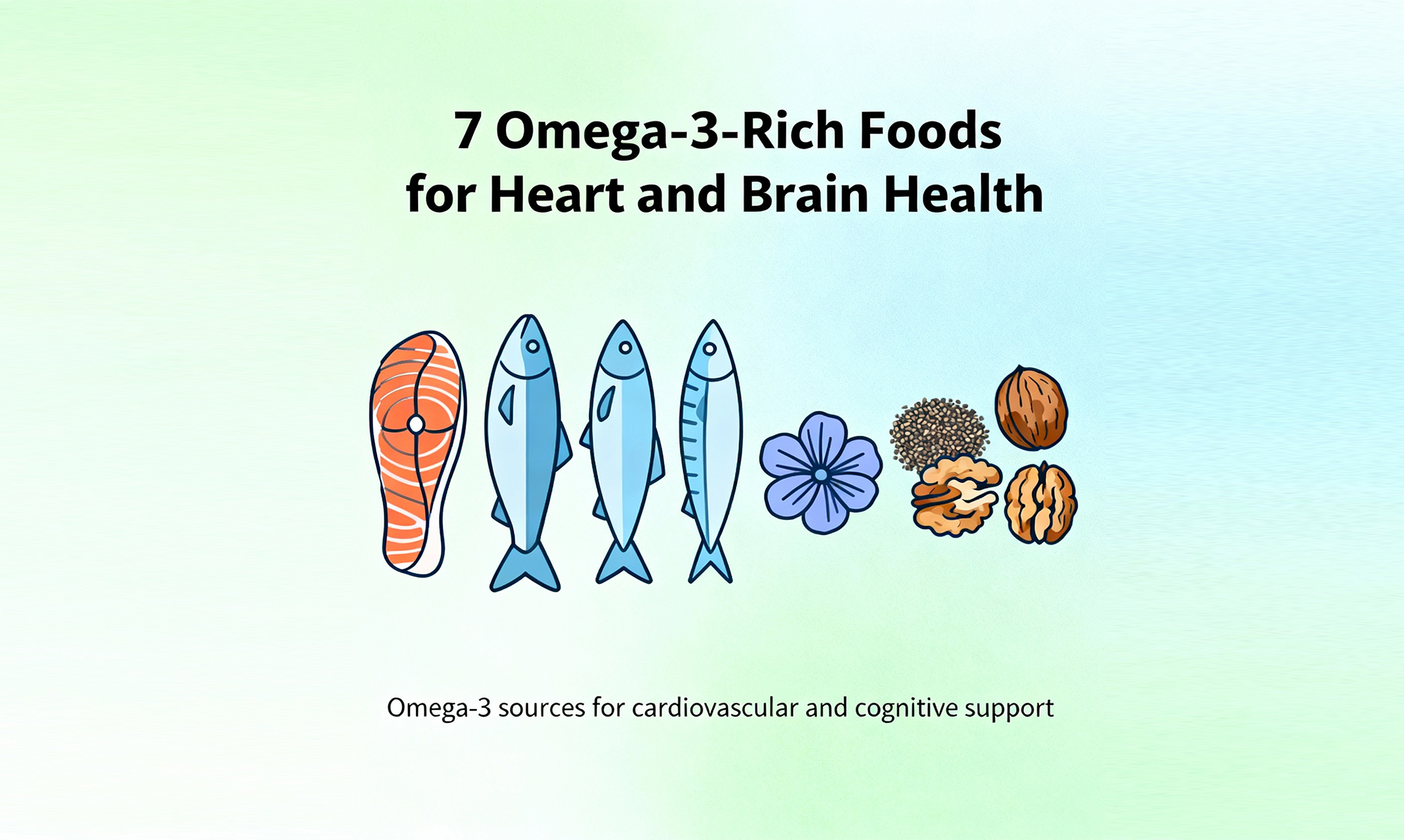Omega-3 fats—especially EPA and DHA—help reduce triglycerides, support normal heart rhythm, and contribute to brain structure and function; ALA from plant foods complements intake when fish is limited. Aim for 2 servings of fatty fish per week and add ALA sources daily for coverage.
What are omega-3s
Omega-3s are essential fats in three main forms: EPA and DHA (mostly from fatty fish/seafood) and ALA (from plant foods like flax, chia, walnuts). EPA/DHA are directly used for heart, brain, and anti‑inflammatory pathways, while ALA can convert in small amounts to EPA/DHA.
Top 7 omega-3–rich foods
- Salmon
- Why it’s great: Rich in EPA and DHA, supports healthy triglycerides and heart rhythm.
- How to use: Grill or bake 2–3 times weekly; pair with lemon, herbs, and olive oil.
- Mackerel
- Why it’s great: One of the highest EPA/DHA fish; also dense in vitamin B12 and selenium.
- How to use: Pan‑sear fillets or add smoked mackerel to salads.
- Sardines
- Why it’s great: Small oily fish with high omega‑3s; often lower mercury than large fish.
- How to use: Canned in olive oil for toast, pasta, or salads.
- Herring
- Why it’s great: Excellent EPA/DHA content and a traditional heart‑healthy staple.
- How to use: Eat grilled, pickled, or smoked with whole‑grain sides.
- Anchovies
- Why it’s great: Potent EPA/DHA in small portions; easy to add as a flavor base.
- How to use: Melt into sauces, dressings, or top pizzas and salads.
- Flaxseed (ALA)
- Why it’s great: One of the richest plant sources of ALA; adds fiber and lignans.
- How to use: Use ground flax (not whole) in smoothies, oats, and yogurt; consider flaxseed oil as a cold finishing oil.
- Chia seeds (ALA)
- Why it’s great: Very high ALA plus fiber for satiety and gut health.
- How to use: Make chia pudding, sprinkle on bowls, or stir into batter; hydrate before eating for best texture.
Optional swaps and additions:
- Walnuts (ALA) for snacking and baking.
- Trout, tuna (skipjack/albacore in rotation), and herring roe/caviar for variety.
- Fortified eggs and dairy if fish intake is low.
Heart and brain benefits (quick science)
- Heart: EPA/DHA help lower triglycerides, support normal heart rhythm, and may modestly lower blood pressure; overall patterns align with lower cardiovascular risk.
- Brain: DHA is a structural fat in the brain and retina; adequate intake supports cognition and visual function across the lifespan.
How much to eat
- Fish: Target 2 servings/week of fatty fish (about 170–240 g total). If relying on plants, include ALA sources daily and consider algae‑based DHA/EPA supplements if you don’t eat fish.
- Daily ALA: About 1.1 g (women) to 1.6 g (men); you can reach this with 1 tbsp ground flax or 1 tbsp chia.
Budget and India-friendly picks
- Sardines and mackerel (including Indian mackerel/“bangda”) are affordable and widely available.
- Add walnuts, flaxseed (alsi), and chia to keep costs low while boosting ALA.
- Hilsa and rohu also provide omega‑3s; rotate with seasonal availability.
Safety notes
- Choose low‑mercury fish (sardines, salmon, mackerel, anchovies). Limit high‑mercury species (king mackerel, shark, swordfish).
- Use flaxseed oil only as a cold finishing oil (low smoke point).
- If on blood thinners or preparing for surgery, consult a clinician before high‑dose fish oil supplements.
7-day omega-3 meal ideas
- Mon: Sardine tomato–olive pasta; chia yogurt bowl.
- Tue: Grilled salmon with quinoa and greens; walnut snack.
- Wed: Flax oat porridge; mackerel salad with lemon and dill.
- Thu: Anchovy‑garlic sautéed greens; chickpea salad with olive oil.
- Fri: Baked herring with potatoes; chia pudding dessert.
- Sat: Tuna (skipjack) lettuce wraps; ground flax in smoothie.
- Sun: Salmon tikka with brown rice; walnut cucumber raita.
SEO tips for your post
- Primary keyword: “omega-3 foods” or “foods high in omega-3”
- Secondary: “fatty fish for heart health,” “omega-3 for brain,” “ALA vs EPA DHA,” “best omega-3 sources”
- Use a comparison table (EPA/DHA vs ALA, typical serving sizes), add FAQ schema (e.g., “Is plant omega-3 enough?”), and alt text like “salmon rich in omega-3.”

